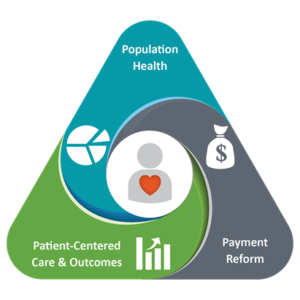 As healthcare providers continue to pursue the triple aim, leading hospitals are turning to data analytics to identify major areas for improvement in daily operations. All three of the triple aim objectives – patient experience, population health and cost – can be attacked in various ways by analyzing high fidelity data for trends and patterns.
As healthcare providers continue to pursue the triple aim, leading hospitals are turning to data analytics to identify major areas for improvement in daily operations. All three of the triple aim objectives – patient experience, population health and cost – can be attacked in various ways by analyzing high fidelity data for trends and patterns.
Using data analytics to chase the triple aim requires the presence of 2 inputs – clean data and tools to analyze that data. Without these, data analytics efforts may fall short of a hospital’s expectations. As this article by Philip Betbeze at HealthLeaders Media reports:
Data without organizational tools is like trying to find your way around a dark room that you’ve never been inside. You can feel your way around using intuition and logic, but progress is slow, and mistakes can hurt you.
In healthcare, data is ubiquitous, but it’s also largely unstructured and unanalyzed, as anyone who has tried to interpret it knows. This problem has left the industry in a dark room in terms of using that information strategically—until recently.
Developing operational and strategic imperatives from all that data is dependent upon analytics—the discovery and interpretation of meaningful patterns. Analytics, to extend the analogy, is a necessary source of light. To deal strategically with everything from eliminating variation in clinical interactions to reducing overutilization to improving patient outcomes, healthcare leaders need technological solutions to assist clinician decision-making at the care site, where the majority of decisions involving cost and outcomes are made.
For these and other reasons, leaders are making critical decisions on the tools that will help them make sense of their data to not only drive smart clinical decision-making, but to allocate scarce resources toward gaining efficiency and competing on cost.
Analytics, in short, is critical to demonstrating value, says Richard Vaughn, MD, chief medical information officer at St. Louis–based, 20-hospital SSM Health.
“The differentiator in the marketplace will be folks who have the data in the right format and know how to use it,” he says. “Analytics helps us use our data as a strategic resource.”
To enable that strategic resource, he adds that the data has to be clean, organized, and it has to connect to the health system’s care delivery platform.
“We have to get the data oriented properly and then make sure it’s sitting in the care delivery stack,” he says.
Analytics helps make the connection between higher quality and lower cost, says Timothy Sielaff, MD, the chief medical officer at Allina Health in Minneapolis. He says the 12-hospital health system is probably ahead of the curve in using data to find meaningful insights that can translate to higher-quality care, and the virtuous circle that results from higher-quality care is that it’s also less expensive.
“The highest-cost care is almost never the highest quality,” he says. “In fact, the incremental cost-effectiveness ratio rarely favors more expensive and better.”
Also critical to effective insights from data analytics is the ability to attribute data to individual practitioners, says Kathleen Sanford, RN, senior vice president and chief nursing officer with Catholic Health Initiatives, largely because individuals don’t generally accept conclusions from aggregated data as readily as they do from their own data.
“It’s difficult even now to get people to accept evidence-based practices unless it’s their own evidence,” she says.”
Read the article at: Analytics Help Health Systems Improve Quality, Lower Costs
As the article states, both clean data and the right tools are required to have success in any data analytics project. If your hospital has any holes in its data in the procedural areas, consider software solutions such as iRISupply that can automate the capture and documentation of implants and supplies in surgical settings, where hospitals make and spend almost half of their dollars. These systems provide the data and the tools necessary to improve outcomes while reducing costs in procedural areas. The marriage of high fidelity data and cutting edge analytics make iRISupply a worthwhile investment for any provider pursuing the triple aim.
